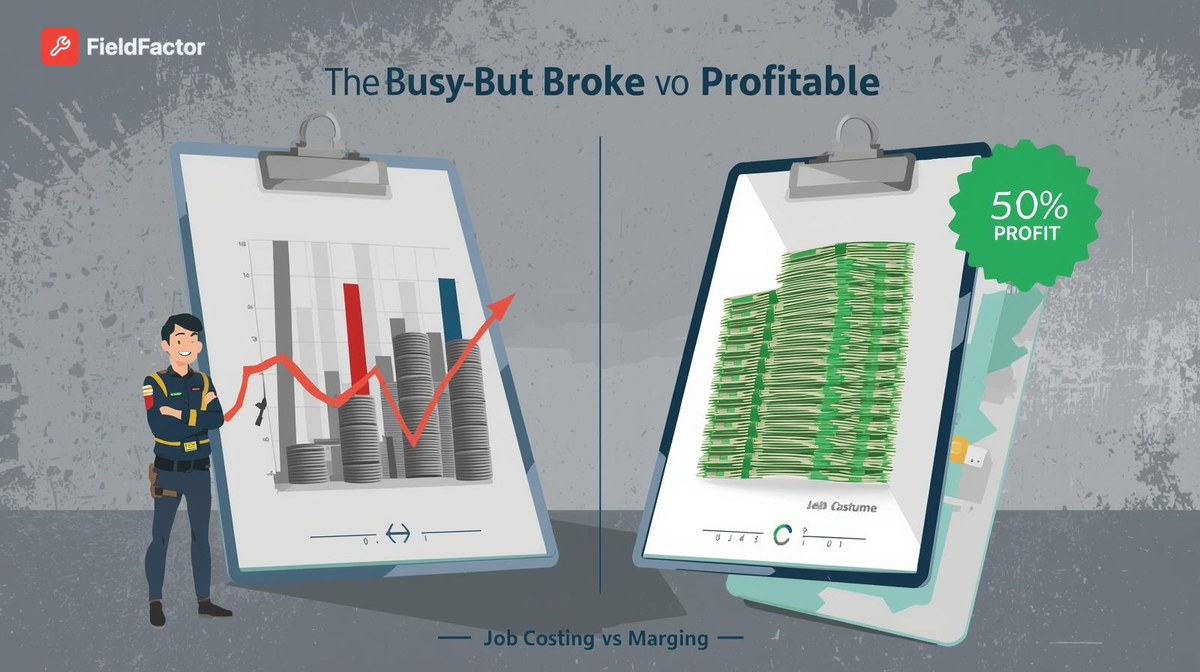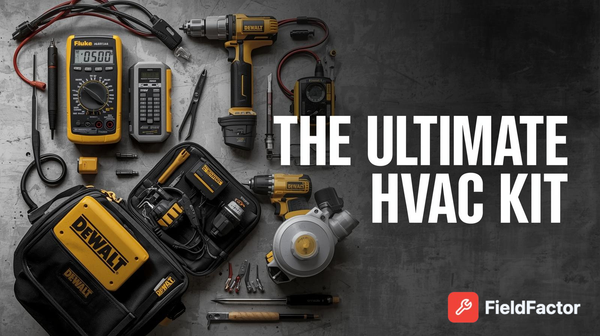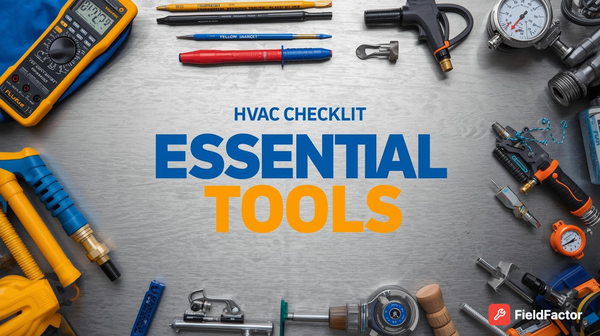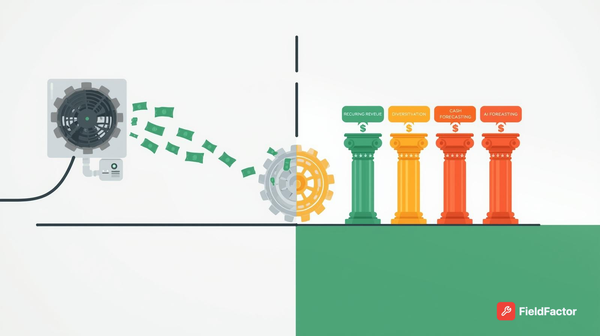Job Costing 101 for HVAC: How to Accurately Price for Profit, Not Just Volume in 2025
HVAC Owners: Stop pricing for volume! Learn the 4-step job costing formula to secure 50-60% gross margins and 12-15% net. Implement flat-rate pricing and software to stop losing $250k annually on underpriced jobs. Price smarter, not harder.

Picture this: You're a solo HVAC contractor in Dallas, sweating through a 100°F attic to fix a leaky coil. The job takes 2 hours, costs you $150 in parts and gas, and you bill $300—feels like a win. But after overhead (truck maintenance, insurance, marketing), your take-home? $120. Multiply by 550 jobs a year: $66,000 revenue, but only $20,000 profit after 10-15% margins erode from underpricing. Now imagine flipping it: Accurate job costing turns that $300 into $450, boosting gross margins to 50-60% and netting $75,000 on the same volume—enough for a new van and a vacation.
In the $69.85 billion U.S. HVAC services market—surging to $94.71 billion by 2030 at a 6.28% CAGR amid extreme weather (20-30% call spikes), IRA green retrofits (20 million heat pumps), and a 110,000-technician shortage—pricing for volume is the trap killing 70% of small firms' profits. Job costing—tracking labor, materials, and overhead per ticket—isn't accounting jargon; it's your profit GPS, ensuring 40-60% gross margins and 12-15% net, per ServiceTitan benchmarks from 5,000+ firms. Errors here? 20-30% underpricing, $50-200 lost per job, and $250k annual hits for $1M ops.
This 2025 101 guide—data-driven from ACCA, QuickBooks HVAC pricing reports, and storytelling from contractors like Texas solo operator Mike R. (who flipped $66k to $120k net via costing)—breaks it down: The formula (labor 40-50%, materials 25-30%), benchmarks ($455 avg. ticket, 50% margins), strategies (flat-rate pricing + software), ROI ($50k/Q lift), pitfalls (70% ignore overhead), and trends (AI costing 90% accuracy). Price for profit—your $1M milestone sharpens.
The Pricing Trap: Why Volume Chasing Kills HVAC Profits (And the $250k Toll)
Volume feels victorious: 550 jobs/year at $455 avg. = $250k revenue. But without costing, COGS (50-60%) and overhead (20%) devour 70-80%, netting 5-8%—$12.5k-20k, per ACCA. Mike R.'s story? "Chased $300 tickets—$66k rev, $20k profit. Felt busy, broke." Costing flipped it: $455 tickets, 50% margins, $120k net.
The Hidden Costs of Bad Pricing: $250k Annual Leak
| Pricing Error | Frequency | Per-Job Loss | Annual Impact ($1M Firm) | Fix with Costing |
|---|---|---|---|---|
| Underpricing (No Overhead) | 70% jobs | $50-100 | $100k-150k | Track 20% overhead for 10% margin lift. |
| Material Waste (Poor Tracking) | 20-30% | $25-75 | $50k-75k | Inventory apps cut 25% waste. |
| Labor Overruns (No Estimates) | 15-25% | $50-150/hr | $50k-100k | Time tracking = 20% efficiency. |
| Total | - | - | $200k-325k (10-15% erosion) | 50-60% gross, 12-15% net. |
*Data: QuickBooks/ServiceTitan 2025. X Voice: "HVAC pricing for volume? $300 tickets = broke busy. Costing saved my sanity." (Mike R., Sep 2025).
Job Costing 101: The Formula to Price for 50-60% Gross Margins
Job costing = Total Costs (Labor + Materials + Overhead) + Markup (40-60% for profit). For a $455 AC repair: Labor $100 (2 hrs @ $50), Materials $150, Overhead $50 (10% rev) = $300 costs; Markup 52% = $455 ticket, $155 profit.
The HVAC Job Costing Formula: Step-by-Step
- Labor Costs (40-50%): Hours × Rate ($25-35/hr tech + 20% benefits). Example: 2 hrs @ $30 = $60; Track via Jobber for 20% accuracy.
- Materials (25-30%): Parts markup 50-100% (capacitor $10 cost → $20-30). Forecast via ServiceTitan (25% waste cut).
- Overhead (10-15%): Allocate shop rent, marketing (7% rev), insurance ($5k/year). $50/job on $455.
- Markup for Profit (40-60%): Costs × 1.67-2.5 = Ticket. 52% avg. for 12-15% net.
Total: $300 costs × 1.52 markup = $456 ticket, $156 profit (52% gross).
Job Costing Benchmarks for HVAC (2025)
| Job Type | Avg. Ticket | Labor % | Materials % | Overhead % | Gross Margin | Net Profit % |
|---|---|---|---|---|---|---|
| Repair | $455 | 40% ($182) | 30% ($137) | 10% ($46) | 50-60% | 12-15%. |
| Maintenance | $199 | 50% ($100) | 20% ($40) | 10% ($20) | 55% | 15% recurring. |
| Install | $3,500 | 45% ($1,575) | 35% ($1,225) | 10% ($350) | 45-55% | 10% (high ticket). |
*Sources: ACCA/ServiceTitan 2025.
Strategies to Master HVAC Job Costing: Price for $50k/Q Profit Lifts
- Adopt Flat-Rate Pricing: $455 standard repair vs. hourly—52% margins, 20% faster billing. Build a price book (Jobber $69/mo) for consistency.
- Track with Software: ServiceTitan/QuickBooks ($300/mo) = 20% accuracy, 25% waste cut—$50k/Q lift.
- Factor Overhead Realistically: 10-15% allocation ($46/job); Review quarterly for 10% margin gains.
- Upsell with Data: Costing reveals margins—bundle duct cleaning (+$200, 25% attachment).
- Annual Reviews: Adjust for inflation (4-6% hikes); Top firms hit 12-15% net.
ROI: $5k setup = $50k/Q (10% lift on 550 jobs).
Case Studies: HVAC Contractors Pricing for Profit, Not Volume
- Mike R. Solo (TX): Switched to costing: $300 to $455 tickets, 52% margins—$66k to $120k net on same volume.
- ServiceTitan Mid-Firm: Job costing software: 20% accuracy, 25% waste cut—$50k/Q lift, 12% net.
- ACCA Benchmark Firm: Flat-rate + tracking: 50-60% gross, $100k/tech revenue.
Pitfalls: Why 70% of HVAC Pricing Fails (And Fixes)
- Volume Over Profit: $300 tickets = 5% net—Fix: 52% markup formula (+$100k).
- Ignoring Overhead: 20% leak—Fix: 10-15% allocation ($50/job).
- No Software: 20% errors—Fix: QuickBooks ($30/mo).
Future Trends: HVAC Job Costing in 2026—AI and Green Pricing
- AI Costing: 90% accuracy by 2026 (ServiceTitan AI); 30% waste cut.
- Green Premiums: Heat pump pricing +20% ($5k-10k tickets).
- Dynamic Models: Real-time markups for 15% margins.
X Tip: "HVAC job costing: $455 tickets = 52% margins. Volume's vanity—profit's king!" (Oct 2025).
Conclusion: Master Job Costing—Price for 50-60% Margins and $50k/Q Profits
Job costing flips volume traps into profit machines: Labor 40-50%, materials 25-30%, overhead 10-15%, markup 40-60% for $455 tickets and 12-15% net. Adopt flat-rate, track with software, review quarterly—your $250k revenue nets $75k+. Download our free Costing Calculator—what's your avg. margin? Comment below.





